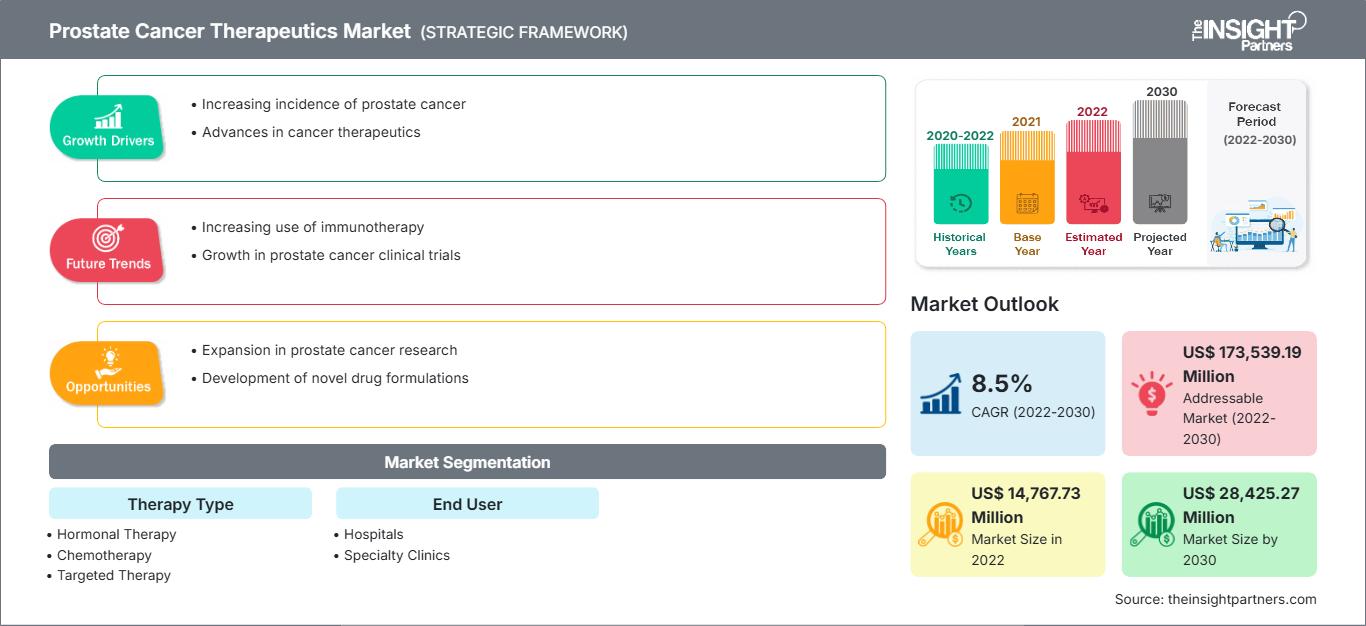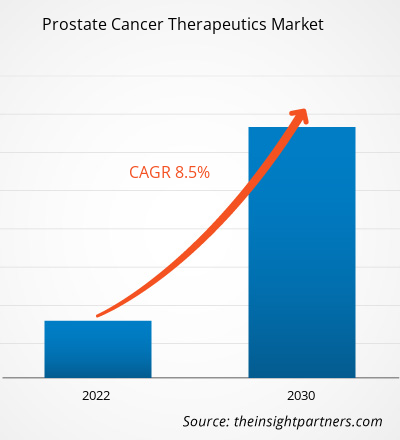[Rapport de recherche] Le marché des thérapies contre le cancer de la prostate devrait passer de 14 767,73 millions de dollars américains en 2022 à 28 425,27 millions de dollars américains d'ici 2030 ; il devrait enregistrer un TCAC de 8,5 % de 2022 à 2030.
Analyses du marché et point de vue des analystes :
Le marché des thérapies contre le cancer de la prostate est en pleine expansion grâce à l'augmentation des activités de R&D visant à introduire de nouveaux composés médicamenteux, à l'augmentation du nombre de cas de cancer de la prostate et à l'augmentation du soutien gouvernemental au diagnostic du cancer de la prostate. De plus, la disponibilité de produits avancés par les acteurs du marché stimule la croissance du marché. En janvier 2023, BDR Pharmaceutical a lancé une version générique de l'apalutamide, utilisée pour traiter le cancer de la prostate en Inde. Le médicament est lancé sous la marque APATIDE et est prescrit pour traiter le cancer de la prostate non métastatique résistant à la castration et le cancer de la prostate métastatique sensible à la castration.
Moteurs de croissance et défis :
Le cancer de la prostate est l'un des problèmes de santé les plus courants chez les hommes, en particulier chez les hommes âgés de 50 ans et plus. Il est surtout fréquent chez les hommes obèses ayant des antécédents familiaux de cancer de la prostate. Le cancer de la prostate est une menace silencieuse, car il se développe souvent sans symptômes visibles. Par conséquent, la détection précoce de ce cancer n'est pas si facile. La majorité des cancers de la prostate prennent naissance dans la région périphérique de la prostate. Pour que les symptômes deviennent apparents, le cancer doit atteindre une taille telle qu'il exerce une pression sur l'urètre, ou une douleur osseuse due aux métastases peut être le symptôme initial d'un cancer de la prostate avancé dans certains cas. Cependant, toute personne âgée de 50 ans ou plus présentant des symptômes des voies urinaires inférieures, une dysfonction érectile ou une hématurie doit envisager la possibilité d'un cancer de la prostate. Le cancer de la prostate est la cinquième cause de décès par cancer chez les hommes dans le monde et le deuxième cancer le plus fréquemment diagnostiqué. Malgré une diminution de l'incidence du cancer de la prostate depuis 2000, on observe une augmentation de l'incidence du cancer de la prostate à un stade avancé depuis 2010. Les taux d'incidence et de mortalité du cancer de la prostate diffèrent considérablement. Les pays développés présentent généralement une incidence plus élevée du cancer de la prostate, mais une mortalité plus faible. Le risque de cancer de la prostate aux États-Unis est près de quatre fois supérieur au risque mondial. Selon Novartis AG, en 2020, environ 1,4 million de nouveaux cas de cancer de la prostate et environ 375 000 décès par cancer de la prostate ont été signalés dans le monde. L'augmentation du nombre de cas de cancer de la prostate dans le monde et le faible taux de détection du cancer de la prostate stimulent la croissance du marché des traitements contre le cancer de la prostate.
Vous bénéficierez d’une personnalisation sur n’importe quel rapport - gratuitement - y compris des parties de ce rapport, ou une analyse au niveau du pays, un pack de données Excel, ainsi que de profiter d’offres exceptionnelles et de réductions pour les start-ups et les universités
Marché des thérapies contre le cancer de la prostate: Perspectives stratégiques

- Obtenez les principales tendances clés du marché de ce rapport.Cet échantillon GRATUIT comprendra une analyse de données, allant des tendances du marché aux estimations et prévisions.
Segmentation et portée du rapport :
Le marché des traitements du cancer de la prostate est segmenté en fonction du type de traitement, de l'utilisateur final et de la géographie. Le marché des traitements du cancer de la prostate, par type de traitement, est segmenté en hormonothérapie, chimiothérapie, immunothérapie, thérapie ciblée, etc. Le marché des traitements du cancer de la prostate, par utilisateur final, est segmenté en hôpitaux, cliniques spécialisées, etc. En fonction de la géographie, le marché des traitements du cancer de la prostate est segmenté en Amérique du Nord (États-Unis, Canada et Mexique), Europe (Royaume-Uni, Allemagne, France, Italie, Espagne et reste de l'Europe), Asie-Pacifique (Chine, Japon, Inde, Corée du Sud, Australie et reste de l'Asie-Pacifique), Moyen-Orient et Afrique (Émirats arabes unis, Arabie saoudite, Afrique du Sud et reste du Moyen-Orient et de l'Afrique), et Afrique du Sud et Amérique centrale (Brésil, Argentine et reste de l'Amérique du Sud et centrale).
Analyse segmentaire :
Le marché des traitements du cancer de la prostate, par type de traitement, est segmenté en hormonothérapie, chimiothérapie, immunothérapie, thérapie ciblée et autres. En 2022, le segment de l'hormonothérapie détenait la plus grande part de marché après la chimiothérapie, et ce même segment devrait enregistrer le TCAC le plus élevé entre 2022 et 2030. La chimiothérapie est considérée comme un traitement important du cancer de la prostate. Dans ce traitement, les médicaments détruisent les cellules cancéreuses nouvelles ou existantes dans les poumons. La chimiothérapie du cancer métastatique de la prostate peut soulager les symptômes. Elle peut également contribuer à réduire le cancer et à améliorer la qualité de vie. Le docétaxel (Taxotere) est considéré comme la norme de soins dans la chimiothérapie du cancer de la prostate chez les patients résistants à l'hormonothérapie. La FDA a également approuvé le cabazitaxel (Jevtana), un médicament de chimiothérapie, pour le traitement du cancer de la prostate résistant à la castration. Il est également utilisé chez les patients atteints d'un cancer de la prostate métastatique qui s'est développé sous docétaxel.
Analyse régionale :
Le marché des traitements contre le cancer de la prostate est segmenté géographiquement en Amérique du Nord, Europe, Asie-Pacifique, Moyen-Orient et Afrique, et Amérique du Sud et centrale. L'Amérique du Nord est le principal contributeur à la croissance du marché mondial des traitements contre le cancer de la prostate. L'Asie-Pacifique devrait enregistrer le TCAC le plus élevé sur le marché des traitements contre le cancer de la prostate entre 2022 et 2030. La croissance du marché des traitements contre le cancer de la prostate aux États-Unis est principalement tirée par l'incidence croissante des cas de cancer de la prostate, les lancements de produits et les initiatives gouvernementales. En juin 2023, Lynparza (olaparib), développé par AstraZeneca et MSD en association avec la prednisone ou la prednisolone et l'abiratérone, a été approuvé aux États-Unis pour le traitement des patients adultes atteints d'un cancer de la prostate métastatique résistant à la castration (CPRCm) suspecté d'être porteur d'une mutation délétère du gène BRCA (BRCAm). De plus, en novembre 2023, la FDA a approuvé l'enzalutamide, un produit fabriqué par Astellas Pharma US, Inc. Ce produit est utilisé pour le traitement du cancer de la prostate non métastatique sensible à la castration (CPRCnm) présentant une récidive biochimique et un risque élevé de métastases (RCB à haut risque).
Aperçu régional du marché des thérapies contre le cancer de la prostate
Les tendances régionales et les facteurs influençant le marché des thérapies contre le cancer de la prostate tout au long de la période de prévision ont été analysés en détail par les analystes de The Insight Partners. Cette section aborde également les segments et la géographie du marché des thérapies contre le cancer de la prostate en Amérique du Nord, en Europe, en Asie-Pacifique, au Moyen-Orient et en Afrique, ainsi qu'en Amérique du Sud et en Amérique centrale.
Portée du rapport sur le marché des thérapies contre le cancer de la prostate
| Attribut de rapport | Détails |
|---|---|
| Taille du marché en 2022 | US$ 14,767.73 Million |
| Taille du marché par 2030 | US$ 28,425.27 Million |
| TCAC mondial (2022 - 2030) | 8.5% |
| Données historiques | 2020-2022 |
| Période de prévision | 2022-2030 |
| Segments couverts |
By Type de thérapie
|
| Régions et pays couverts | Amérique du Nord
|
| Leaders du marché et profils d'entreprises clés |
|
Densité des acteurs du marché des thérapies contre le cancer de la prostate : comprendre son impact sur la dynamique commerciale
Le marché des traitements contre le cancer de la prostate connaît une croissance rapide, portée par une demande croissante des utilisateurs finaux, due à des facteurs tels que l'évolution des préférences des consommateurs, les avancées technologiques et une meilleure connaissance des avantages du produit. Face à cette demande croissante, les entreprises élargissent leur offre, innovent pour répondre aux besoins des consommateurs et capitalisent sur les nouvelles tendances, ce qui alimente la croissance du marché.

- Obtenez le Marché des thérapies contre le cancer de la prostate Aperçu des principaux acteurs clés
- Analyse historique (2 ans), année de base, prévision (7 ans) avec TCAC
- Analyse PEST et SWOT
- Taille du marché Valeur / Volume - Mondial, Régional, Pays
- Industrie et paysage concurrentiel
- Ensemble de données Excel
Rapports récents
Rapports connexes
Témoignages
Raison d'acheter
- Prise de décision éclairée
- Compréhension de la dynamique du marché
- Analyse concurrentielle
- Connaissances clients
- Prévisions de marché
- Atténuation des risques
- Planification stratégique
- Justification des investissements
- Identification des marchés émergents
- Amélioration des stratégies marketing
- Amélioration de l'efficacité opérationnelle
- Alignement sur les tendances réglementaires




















 Obtenez un échantillon gratuit pour - Marché des thérapies contre le cancer de la prostate
Obtenez un échantillon gratuit pour - Marché des thérapies contre le cancer de la prostate